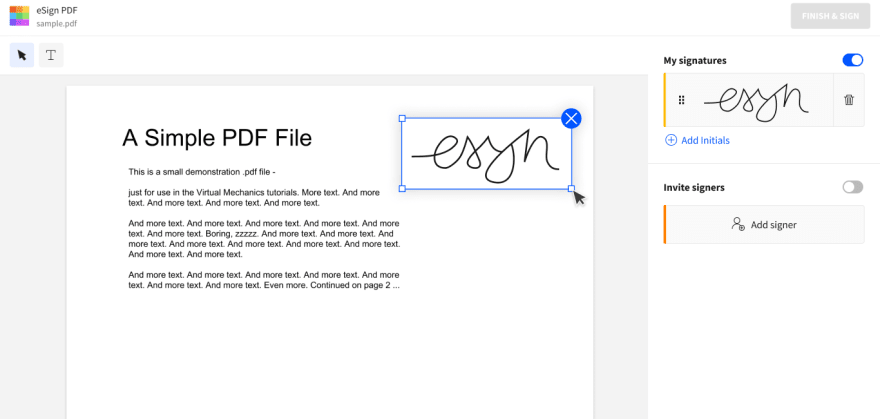How long did the process of signing and delivering documents take, let’s say, 10 years ago? And how long does it take now? We all know that many documents require a signature. But if before the only way to sign agreements was by hand, digitalization has taken the signing process to a whole new level.
Let’s discover the definitions of wet signatures as well as electronic and digital ones, their differences, and when you can use each of them to authorize documents.
The definition of a wet signature
When a person physically marks a document either with a pen, name seal, or another writing device, he is leaving a wet signature.
It does not necessarily need to be a person’s name written with an ink pen. Everything from stamp marks, seals, cursive, or just an “X” is legally distinguished as a wet signature as long as it is physically done. Depending on the company, rules might still vary, hence it is usually advised to check before signing a document to ensure your signature is valid.
Nowadays, thanks to digital technologies, electronic signatures can carry similar legal effects when it comes to signing various agreements. Besides, with electronic signatures, businesses can complete the document authorization within a day without the need to print it, sign, scan, and send it back.
The definition of an electronic signature
Marks on electronic documentation that have an intention to serve as a person's document authorization are determined as electronic signatures. The latter can be done by selecting a checkbox, through a keystroke or a simple stylus swipe.
You are giving an electronic signature when you, signing up for Netflix and creating an account with them, check several boxes related to their policies. Your name at the end of every email you send is also considered an electronic signature.
An electronic signature can have a number of different forms, including:
Entering pin code when you withdraw money from an ATM
Sending a scanned document with your wet signature
Typing your first and last name in an electronic contract
A lot of people also recreate their handwritten signature with the help of their smartphones to have it in an electronic format and reuse for various purposes.
Electronic signing is easy to implement and it eliminates a lot of hassle around piles of paper. However, due to security reasons, electronic type of signature is defined as low trust because it doesn’t carry any proof of the identity of the signer and doesn’t track the possible changes that can occur after the document was already signed.
To secure documents that are signed electronically, digital signatures like SmallPDF were introduced.
The definition of a digital signature
One of the most reliable methods for executing electronic agreement authorization is through digital signatures. The latter includes an authority certificate to validate the signatory and ensure the sent document was not changed after it was signed.
Besides, all electronic communication is also signed with a private decryption key of the sender and can be verified by those who have access to the public key of the sender. Such a system ensures that two parties are exactly who they say they are, and all the exchanged content between them has not been edited.
A digital signature example is when you select a platform for eSignature to sign and share your document. Once you are done with editing, the platform offers to leave a digital signature to secure it and eliminate the possibility of someone unauthorized viewing it.
A digital signature serves as your unique fingerprint. While electronic signatures confirm your agreement with the T&Cs of a particular contract, a digital signature verifies its authenticity. The process of signatory and originator identification is the main difference between the two signatures.
Advantages and Disadvantages of Wet Signatures
Although both signatures, digital and electronic, are legally accepted across the world, there are many situations when you will be asked to sign a contract with a wet signature.
A signature serves as an approval between several parties involved. Hence, one of the advantages of working with a wet signature is that all participants should be present in order to get everything signed. People can discuss the terms of the agreement, confirm all the details, and ensure that each party agrees with everything before signing.
Despite this, there exist several reasons electronic signatures prevail when it comes to the process of signing different types of agreements.
First, the amount of effort required to get a document signed using a wet signature is tremendous. It might seem okay, but on a bigger scale, when a company needs to sign a number of documents with different clients, the process can be seriously delayed.
Second, printed documents can be damaged, stolen, or just lost, either outside of the office or in a pile of other papers. That does not happen with electronic documentation which requires no printing or scanning and can be safely saved on the cloud.
Third, paper documents take a lot of space for storage, tons of effort to manage, and a lot of people’s resources to fill them. When you need to prepare a contract within no time, electronic documents will be lifesavers. Besides, it’s far easier then to find the needed file on the laptop rather than go looking for it among thousands of stacks of printed files.
Advantages of Digital Signatures
Shifting to digital signing might be overwhelming at first, but is definitely worth the effort.
There exist quite a lot of solutions on the market that provide companies with a ready-made system where they can store and easily manage all the electronic documentation and sign them securely and with no effort.
Contracts can be created with customized digital signatures which will ensure absolute confidentiality and security of the signed documents. You can also create your own lists of those people who need to sign an agreement and track the entire process without moving from the laptop.
Digital signatures save you time and eliminate most of the routine work when it comes to creating and signing contracts. With digital signatures, it is easy to verify the identity of the signer, obtain a legal signature, and store the received documents with no hassle and additional costs.
Wrap Up
The rise of digitalization and process automation has changed the way of collecting signatures. From using ink to sign papers to shifting to name seals, from utilizing faxes to moving to electronic means of authorization, people are looking for means to conduct things quicker than they used to. In a fast-paced environment like ours, the less time spent on the process, the better.
Although wet signatures are still used in a number of cultures, many companies, service providers, and mobile apps have moved to electronic means of signing documents. The latter is fast and efficient and eliminates the need to process and store piles of paper.
For people who value privacy and security, digital signatures are a way to make sure the agreement is signed by the right person, is safely transmitted, and undergoes no change after being signed. Besides, with a vast amount of digital platforms offering customized and safe tools for signing documents, it has become even easier to make a shift from traditional wet signatures to a new world of digitalization.





Top comments (1)
Hello there! On the whole, I knew the difference. I want to say that electronic signature is a very useful thing. I put off creating it for a long time and regretted it. But still I would like to say that I did not order my electronic signature for nothing on the site, because I can't work without it.